Cyber Security Resume Example & How to Write Tips 2024
The job search can be stressful sometimes, even if you know all there is to know about malware, firewalls, and other aspects of information technology. Naturally, you want to be sure that you paint yourself as the best potential hire – but what’s the best way to do that? Even with top skills and excellent education, you still need to sell recruiters on your abilities.
That’s why you should make sure you’ve cleaned up and dusted off your cyber security resume. Having experience (or education) matters, but it goes far beyond that. The correct information needs to be laid out to show you have the skills required for that dream position.
If it’s been a while since you’ve written a resume, that can seem pretty daunting.
That’s precisely why this guide exists. We’ll help you understand what hiring managers want to see on cyber security resumes. Everything from the information to include and the format to use will be explained, so all you have to do is fill in your unique information and get that resume onto someone’s desk. Use the tips below to increase your chances of an interview.
Cyber Security Resume Example
So, you want a great cyber security resume PDF that you can hand to a hiring manager? Whether you’re emailing it in or doing this the old-school way, you have to make sure that your resume looks its best. It would be ideal if you stood out in a good way – but without going too far outside the boundaries of a typical cyber security resume.
One way to make that easy is by checking out a selection of cyber security resume examples. If a lot of people are including a particular resume section (or formatting it in similar ways), that might be what recruiters are expecting to see. Throughout this guide, we’ll share examples that are up to date and perfect for your 2022 cyber security resume.
A cyber security resume sample is also an excellent option for laying out your professional document. You can take hints from a premade resume and use it to make your own.
Or make it even simpler by making use of a resume template. These templates are already formatted, so you just add in information about yourself, your job experience, and education – and you can turn in a job application you can be proud of.
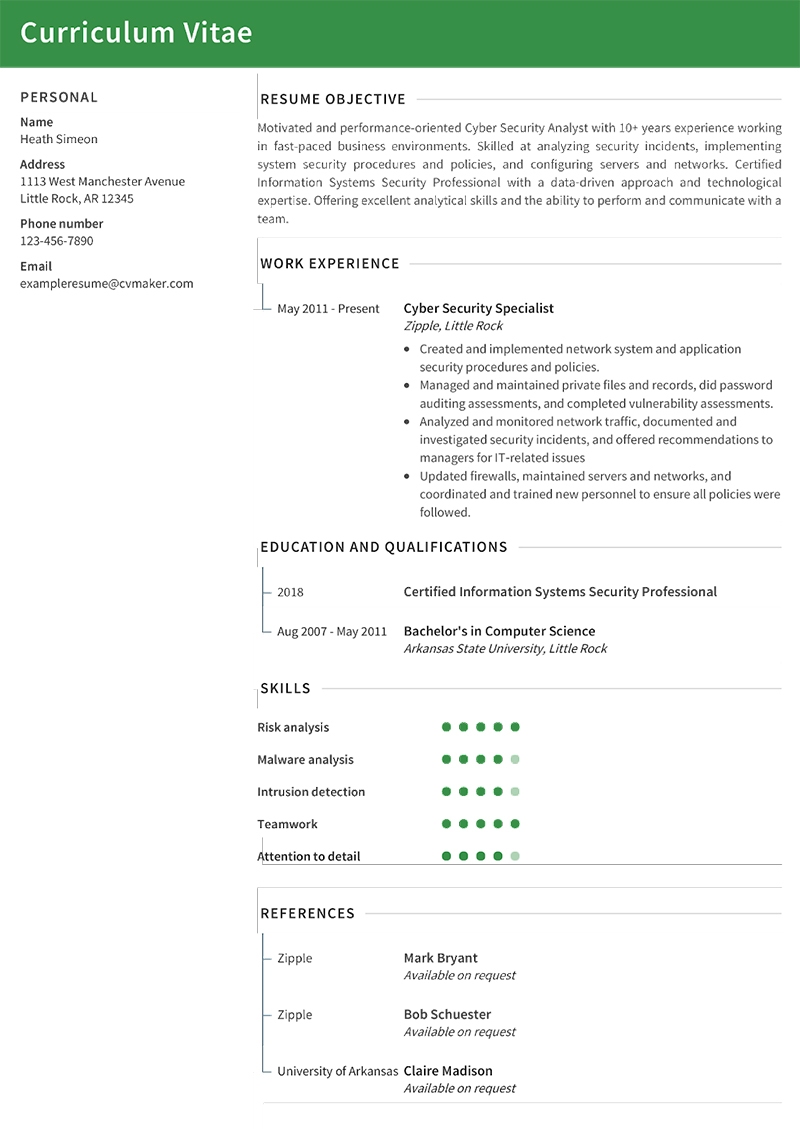
How to Write a Great Cyber Security Resume: A 2024 Guide to Information Security Resumes
Whether you are building a cyber security analyst resume or a cyber security engineer resume, there are several things that you will want to include. Some of the most important items to share are your skills, what work you’ve done in the past, and whether you have any degrees. It should give a hiring manager all the information needed to decide whether to move forward with your application.
At the same time, you don’t want to include other things. For instance, cyber security resume buzzwords should be avoided. Yes, it’s important to share what you could do in this position. However, keep in mind that the person reading the resume might not know every piece of jargon common to the industry. So use industry-specific terminology in moderation.
One of the most important things to keep in mind is that lots of people are applying to cyber security positions. Standing out has never been more critical. The end result of your work on a resume should include only relevant information that ensures you look like a great catch as an employee. You’ll do that through the use of the following resume sections:
- Personal information
- A resume objective
- Professional work experience
- Education
- Skills
- References
The majority of the rest of this guide will focus on each of these sections one at a time. We’ll make sure you know what the section is all about, the best information to share, and how to format what you do share, so it looks good and keeps eyes on it. Since resumes are often looked at for less than a minute, we want to be sure you have the best chance of being noticed from the second your resume hits someone’s inbox.
Section #1: Personal Information
The first section in a cyber security resume is all about your personal information. To break it down into a single requirement, this is the section where you’ll ensure a hiring manager can get in contact with you after reading your resume. So you need your name front and center, along with at least two different ways to get in touch with you. This is an easy section to start with before moving to more challenging parts of the cyber security resume.
Personal Information Example
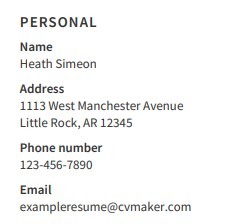
Once you’ve fired up Microsoft Word or opened a resume template, you’ll want to create a personal information section similar to the one in the image above. As you can see, it’s straightforward and only has the most pertinent information. It has the applicant’s name, location, and how to reach them via phone or email.
Are you thinking about adding a link to LinkedIn or another professional network? Unless it’s asked for in the application, it might be best to leave it off. However, adding it isn’t a faux pas. It just adds additional information and might clutter the section. However, if the hiring manager asks for other information, make sure it’s included.
How to Format This Section
Sure, you know Linux security, but do you know how to format each section of your cyber security resume? Recruiters know what they want to see, and when it comes to personal information, it needs to be easy to read and brief. It can be included on a side column like you see above or you can choose to make it a section in the middle of the document.
Use standard fonts and go with a color that looks good against the background. Otherwise, just place your contact information and move on to the next section.
Section #2: Resume Objective
We’re rolling right into the cyber security resume objective from the personal information section. The first section we looked at is mandatory for obvious reasons. The objective is just as important but for entirely different reasons. The resume objective is the spot where you genuinely sell yourself and what you can do. This applies whether you have a senior resume
with decades of experience or an entry-level cyber security resume with no experience as a sample.
The resume objective is where you pitch yourself. You show what you can do and how your skills have bettered other businesses in the past. But you have to do it in limited words, so being able to pick out the best bits and include them is something you’ll need to learn to do.
Resume Objective for Cyber Security Entry Level Resume

When it comes to a cyber security student resume, you might focus on your university achievements. The entry-level cyber security analyst resume sample above gives you an idea of how this might be put together. Your cyber security intern resume will vary based on what you have done in the past, both in work experience and education.
Remember that the entry-level cyber security resume objective is no more than two to four sentences, so try to add in your best skills for a chance at the job you want.
Resume Objective for Mid-Career Resume for Cyber Security

An IT security resume for someone who has worked in risk management, security architecture, and antivirus will give you more to work with. Of course, you can still mention you have a computer science degree, but the focus will be on what you’ve done in past positions. The image above can give you an idea of how to tie things together and include everything you want.
Resume Objective for Senior Information Security Resume Sample

Last, we want to talk about a resume objective for someone with many years of experience. This is the place to really focus on how much you’ve done with network security, penetration testing, and other industry-specific tasks. You likely have more to say and several achievements to showcase, so look at the job description to decide what to keep and cut.
How to Format This Section
You can see the format in the resume example above. This is something that is going to start off your resume, so it needs to look great and be simple to read. As mentioned, it should be no more than four sentences long. Whenever possible, explain how you’ve helped other businesses succeed. This gives a hiring manager something to imagine when they think about whether you’d be a good fit with the company.
Remember that this will be one of the first things read, so make sure it says something genuine. Quantify your achievements whenever possible by using percentages and other numbers. Showing that you have done incredible things for past employers is a sure way to land a position that offers everything you want in terms of culture, pay, and benefits.
Section #3: Professional Work Experience
As expected, every resume needs a professional work experience section. This is where you share the job title you had at past jobs, initiatives you took on, when you worked where, and more. The primary purpose here is to show what you have done in the past. The work experience section also shows an employer whether you have consistently held employment or not.
Professional Work Experience Example
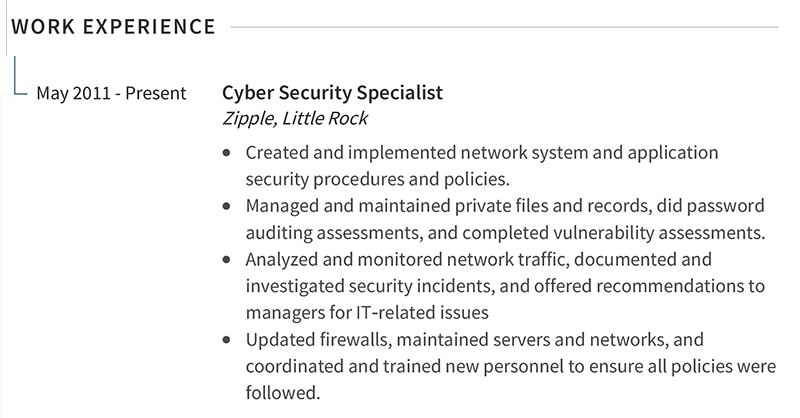
The image above gives you an idea of how this section might look. However, it’s going to depend on what you’ve done in the past. Maybe you were a security manager who focused on security clearance in your last job. Perhaps you have several positions to include that pertain to the dream job you want now.
Use the image as a basis for how this might look with an excellent template.
How to Format This Section
Going with the example above, if your security specialist job is the last one you had, it should go first. This is known as a reverse-chronological resume format and is the most common for cyber security resumes. You put down details about your most recent (or current) position, including the company you worked for, your job title, and when you are with the organization.
Underneath this information, a series of bullet points adds depth to each position. For example, you can include information about the intrusion detection you did, how you fought security risks, and what assessments you were in charge of. Once you’ve completed the first job, you can move on to the second and so on. Just remember not to include too many details since your cyber security resume should be one to two pages long.
Section #4: Education
After getting through information about work experience, it’s time to move into education. This is where you put information about your bachelor’s degree, certifications, and other information related to your education. If nothing else, it’s essential to put your highest degree. Many cyber security positions require a bachelor’s or master’s degree, so hiring managers want to see that reflected.
Education Examples

You can see above that the applicant has their bachelor’s degree listed. They also show they are a Certified Information Systems Security Professional (CISSP). These should be in chronological order, much like the work experience section. So, you might put your bachelor’s in 2010 and then include your CompTIA Security certificate above that if you earned it in 2018.
How to Format This Section
The formatting here is relatively simple for a cybersecurity job. Start with your most recent educational achievement. Then, add the institution where you got a degree or certification, what education you worked through, and when you walked away with a degree. Assuming you have some work experience on your cyber security resume, nothing else needs to be included.
On the other hand, those who are looking at entry-level careers might want to add more information under the education section. For example, you can add in your GPA, classes you took that make you knowledgeable about cyber security, and other achievements that make a case for you being a good hire. But don’t just add extra information for the sake of it if your resume is long enough with skills and work experience.
Section #5: Skills
Your cyber security skills resume will have a special section to focus on your top abilities. This is the section where you add anything you know how to do (and do well) that hasn’t been included elsewhere in the resume. Take a look at the job description to get an idea of the right cyber security resume skills to include. If something seems mandatory and you have the skill, it should be added here.
Skills Example
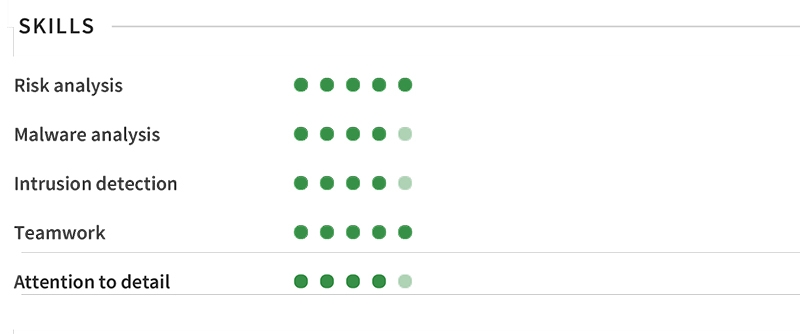
This image of the skills section gives you an idea of how a template can make the things you are good at stand out for recruiters and hiring managers. Add Python, problem-solving, incident response, or whatever else you know you are great at. But make sure these things pertain to the position. If not, they might be better left off unless you apply somewhere else where those skills are needed.
How to Format This Section
Skills are an addition to your professional experience that show what you are capable of. When you make your own list of skills, consider a mixture. For example, hard skills like technical skills and soft skills like excellent communication are equally crucial to a job in cyber security. Even if most of the job involves working alone, you’ll need to communicate with teammates and managers about security issues and other things on a regular basis.
When you format this section, make sure it looks clean. You can use a template like the one featured in the above image to create dots that indicate your proficiency in various skills. Alternatively, you can describe your level of knowledge with each skill using a word or two. This gives better insight into how experienced you are with essential abilities.
Section #6: References
The last section that must be a part of your cyber security resume is the reference section. This is the spot to share information about people who know you can handle all kinds of cyber attacks with ease. References will often be contacted by a hiring manager who wants to ensure you are the right choice for a job, so be selective when you decide who to include.
References Example
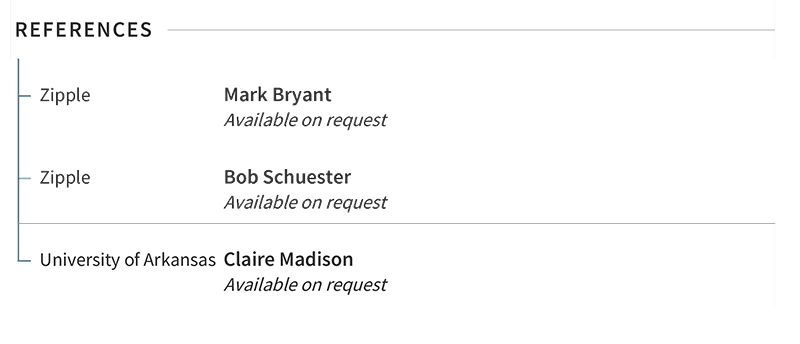
The reference image example above includes cybersecurity professionals, as well as one reference from outside of work. Naturally, you want to make sure the majority of the references you choose have seen you at work and are knowledgeable about what a great employee you are. Otherwise, a personal or educational connection can also be helpful to show you’re someone appreciated in the larger community.
How to Format This Section
When formatting references, first, you need to make a decision. Will you be including contact information on the resume or not? Most recommend not doing so. It can compromise the privacy of your references. As someone in cyber security, that’s probably not the first thing you want to be known for.
Assuming you do not include phone numbers and email addresses, two formats are possible. One merely says, “references available on request” and offers no information beyond that. This can work, but it’s typically not the best choice. So instead, add the names and employers of the references.
Rather than including their contact information, make sure the recruiter knows you will send over that information if needed. You’ll likely want to keep the number of references between three and five to save space, as well.
Other Related Resume Templates
Resume writing doesn’t have to be overwhelming and frustrating. Using our guidelines and tips, you can create a perfect cyber security resume to send to your dream job. On top of that, a cyber security resume template will make things even more straightforward. All you have to do is choose a format, colors you like, and then input your information.
The resume we’ve used as an example is available for your use. However, we also have a selection of resumes for other positions that you can adapt to meet your needs. A few that you might want to consider include the following:
- Web Developer Resume Example
- Data Engineer Resume Sample
- Software Engineer Resume Example
- Computer Technician Resume Sample
- Business Intelligence Analyst Resume Sample
Once you have your resume created, there are only a few more things to do. First, you want to read through the resume and ensure it’s precisely the way you want it to be. Check to be sure it isn’t longer than two pages and use concise wording to cut down on length if needed. Whenever possible, add statistics and numbers to show what you can do.
Before sending the cyber security resume in, be sure it is entirely proofread. You can use a program like Grammarly to be sure there are no errors or issues. Then, look over the formatting and be sure everything looks perfect.
After that, the only thing left to do is turn the resume into a PDF file and send it in. Then, you’re good to go!
Final Points on Cyber Security Resumes
If you follow the above tips, every employer will know you’re diligent about security threats and vulnerability scanning. They’ll also see that you took time and put effort into a resume that fits the job description. As long as you craft an excellent cover letter to go with it, you’ll be sure to gain notice. It could be what gets you that interview you want.
Using samples, examples, and templates, you could have the perfect cyber security resume. Take time to craft a resume that speaks to the position you want, and you’ll have better luck in the job world. Watch out for positions you want, tailor your resume to them, and watch as success comes to you!